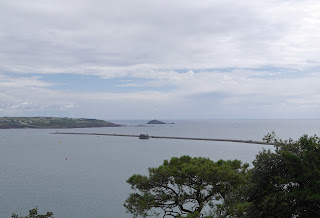View of the Royal William Victualling Yard
We resume our South West Coast Path adventure, now in Cornwall. We pick up the route at the Cremyll Ferry - there has been a ferry here since the 13th century - admire the naval Victualling Yard across the Sound, and immediately enter the grounds of Mount Edgcumbe Park.
We quickly get a view of the house itself at the top of a grassy avenue. It was built 1547-1553 for the Edgcumbe family of Cotehele (Richard Edgcumbe was knighted at the battle of Bosworth and the family later became Earls of Mount Edgcumbe). The house was gutted by German bombing in 1941, along with the centre of Plymouth, and rebuilt in the late 1950s.
The grounds are delightful. Our selective tour takes us past the Orangerie (1760) ...
... and out onto a broad promenade with a view across to Drake's Island.
A grassy section ends with Milton's Temple of 1755. There is a plaque inscribed with lines from Paradise Lost, 'overhead up grew, Insuperable heights of loftiest shade.....'
Then you enter the Deer Park and soon spot a splendid folly on a hill. It dates from 1747 and was built from medieval stone taken from the churches of St. George and St. Lawrence, Stonehouse.
At Redding Point there is good view of the Plymouth Breakwater with the Breakwater Fort behind it. We first encountered this on the Warren Point to Mount Batten leg of the Coast Path.
Now you pass through woodland high above Fort Picklecombe. This was one of the many forts which Lord Palmerston had built to defend against a feared French attack in the 1850s. It has been a residential complex since the early 1970s.
The woodland gave way to a section of low grassy cliff top leading to the twin villages of Kingsand and Cawsand.
Cawsand is the larger of the two and has attractive narrow streets and this fine clock tower. It was erected to commemorate the coronation of George V (1901) and the building it is attached to (locally referred to as the Institute) is used as a community hall.
We climbed up Pier Lane and the sight of the name also in Cornish (Bownder an Kay) brought it home to us that we were in Cornwall. We then passed in front of the one-time Cawsand Fort, dating from the 1860s, but on the site of an earlier battery - it is also now a residential development.
More grassy cliff tops brought us to Penlee Point, which marks the entrance to Plymouth Sound. Here the terrain changed and the final section to Rame Head was along a hedged track, with dense gorse and scrub below. We saw a vast number of Speckled Woods as we walked along.
We were very interested to get our first sighting of the Eddystone Lighthouse as we walked along - too far out to photograph in the gathering gloom. I will try tomorrow. We had of course seen Smeaton's Tower, the the first stone lighthouse there, relocated on Plymouth Hoe.
This stage ends with a view of the Chapel of St Michael, consecrated in 1397, perhaps on the site of an earlier hermitage.
Behind it, on higher ground, is a Lookout Station of the National Coastwatch Institution. Although Coastwatch sounds like an idea for a BBC TV programme, the Institute is a charity which provides volunteers to man Lookout Stations like this which the Coastguard ceased to operate in the 1990s.
Conditions: becoming increasingly cloudy, but quite warm.
Distance: 6.5 miles.
Map: Explorer 108 (Lower Tamar Valley and Plymouth).
Rating: Four stars. Mount Edgcumbe Park was a joy.











No comments:
Post a Comment